高中说课稿三篇
- 格式:doc
- 大小:41.50 KB
- 文档页数:13
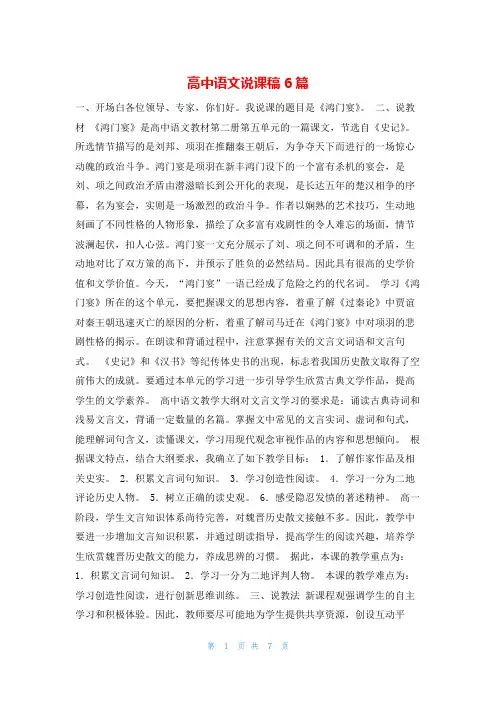
高中语文说课稿6篇一、开场白各位领导、专家,你们好。
我说课的题目是《鸿门宴》。
二、说教材《鸿门宴》是高中语文教材第二册第五单元的一篇课文,节选自《史记》。
所选情节描写的是刘邦、项羽在推翻秦王朝后,为争夺天下而进行的一场惊心动魄的政治斗争。
鸿门宴是项羽在新丰鸿门设下的一个富有杀机的宴会,是刘、项之间政治矛盾由潜滋暗长到公开化的表现,是长达五年的楚汉相争的序幕,名为宴会,实则是一场激烈的政治斗争。
作者以娴熟的艺术技巧,生动地刻画了不同性格的人物形象,描绘了众多富有戏剧性的令人难忘的场面,情节波澜起伏,扣人心弦。
鸿门宴一文充分展示了刘、项之间不可调和的矛盾,生动地对比了双方策的高下,并预示了胜负的必然结局。
因此具有很高的史学价值和文学价值。
今天,“鸿门宴”一语已经成了危险之约的代名词。
学习《鸿门宴》所在的这个单元,要把握课文的思想内容,着重了解《过秦论》中贾谊对秦王朝迅速灭亡的原因的分析,着重了解司马迁在《鸿门宴》中对项羽的悲剧性格的揭示。
在朗读和背诵过程中,注意掌握有关的文言文词语和文言句式。
《史记》和《汉书》等纪传体史书的出现,标志着我国历史散文取得了空前伟大的成就。
要通过本单元的学习进一步引导学生欣赏古典文学作品,提高学生的文学素养。
高中语文教学大纲对文言文学习的要求是:诵读古典诗词和浅易文言文,背诵一定数量的名篇。
掌握文中常见的文言实词、虚词和句式,能理解词句含义,读懂课文,学习用现代观念审视作品的内容和思想倾向。
根据课文特点,结合大纲要求,我确立了如下教学目标: 1.了解作家作品及相关史实。
2.积累文言词句知识。
3.学习创造性阅读。
4.学习一分为二地评论历史人物。
5.树立正确的读史观。
6.感受隐忍发愤的著述精神。
高一阶段,学生文言知识体系尚待完善,对魏晋历史散文接触不多。
因此,教学中要进一步增加文言知识积累,并通过朗读指导,提高学生的阅读兴趣,培养学生欣赏魏晋历史散文的能力,养成思辨的习惯。
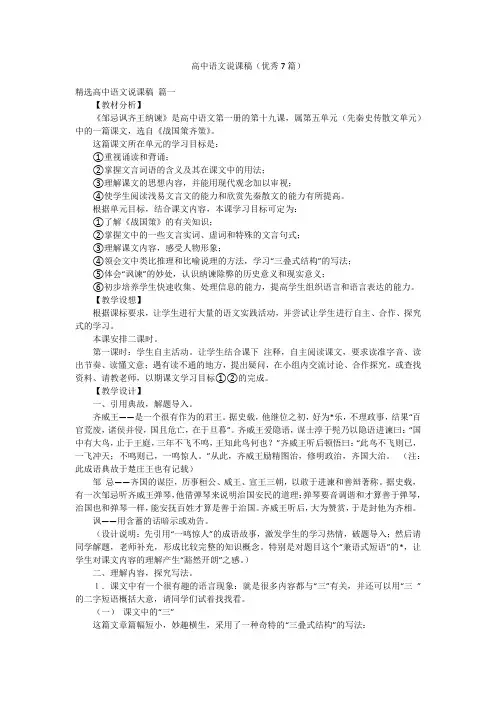
高中语文说课稿(优秀7篇)精选高中语文说课稿篇一【教材分析】《邹忌讽齐王纳谏》是高中语文第一册的第十九课,属第五单元(先秦史传散文单元)中的一篇课文,选自《战国策齐策》。
这篇课文所在单元的学习目标是:①重视诵读和背诵;②掌握文言词语的含义及其在课文中的用法;③理解课文的思想内容,并能用现代观念加以审视;④使学生阅读浅易文言文的能力和欣赏先秦散文的能力有所提高。
根据单元目标,结合课文内容,本课学习目标可定为:①了解《战国策》的有关知识;②掌握文中的一些文言实词、虚词和特殊的文言句式;③理解课文内容,感受人物形象;④领会文中类比推理和比喻说理的方法,学习“三叠式结构”的写法;⑤体会“讽谏”的妙处,认识纳谏除弊的历史意义和现实意义;⑥初步培养学生快速收集、处理信息的能力,提高学生组织语言和语言表达的能力。
【教学设想】根据课标要求,让学生进行大量的语文实践活动,并尝试让学生进行自主、合作、探究式的学习。
本课安排二课时。
第一课时:学生自主活动。
让学生结合课下注释,自主阅读课文,要求读准字音、读出节奏、读懂文意;遇有读不通的地方,提出疑问,在小组内交流讨论、合作探究,或查找资料、请教老师,以期课文学习目标①②的完成。
【教学设计】一、引用典故,解题导入。
齐威王——是一个很有作为的君王。
据史载,他继位之初,好为*乐,不理政事,结果“百官荒废,诸侯并侵,国且危亡,在于旦暮”。
齐威王爱隐语,谋士淳于髡乃以隐语进谏曰:“国中有大鸟,止于王庭,三年不飞不鸣,王知此鸟何也?”齐威王听后顿悟曰:“此鸟不飞则已,一飞冲天;不鸣则已,一鸣惊人。
”从此,齐威王励精图治,修明政治,齐国大治。
(注:此成语典故于楚庄王也有记载)邹忌——齐国的谋臣,历事桓公、威王、宣王三朝,以敢于进谏和善辩著称。
据史载,有一次邹忌听齐威王弹琴,他借弹琴来说明治国安民的道理:弹琴要音调谐和才算善于弹琴,治国也和弹琴一样,能安抚百姓才算是善于治国。
齐威王听后,大为赞赏,于是封他为齐相。
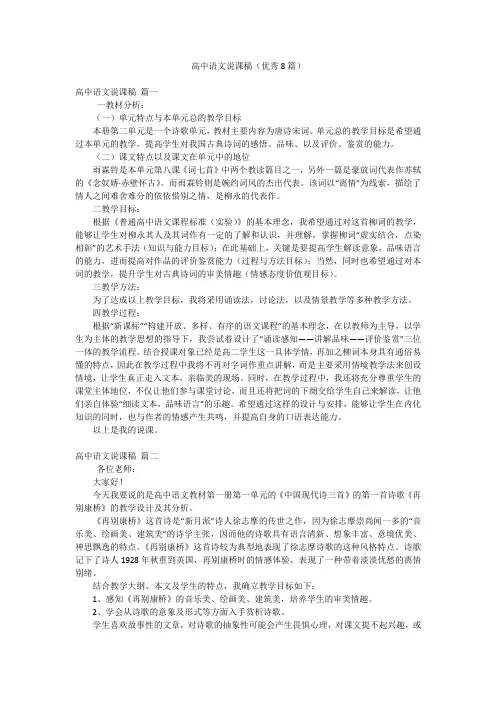
高中语文说课稿(优秀8篇)高中语文说课稿篇一一教材分析:(一)单元特点与本单元总的教学目标本册第二单元是一个诗歌单元,教材主要内容为唐诗宋词。
单元总的教学目标是希望通过本单元的教学,提高学生对我国古典诗词的感悟、品味、以及评价、鉴赏的能力。
(二)课文特点以及课文在单元中的地位雨霖铃是本单元第八课《词七首》中两个教读篇目之一,另外一篇是豪放词代表作苏轼的《念奴娇·赤壁怀古》。
而雨霖铃则是婉约词风的杰出代表。
该词以“离情”为线索,描绘了情人之间难舍难分的依依惜别之情,是柳永的代表作。
二教学目标:根据《普通高中语文课程标准(实验)》的基本理念,我希望通过对这首柳词的教学,能够让学生对柳永其人及其词作有一定的了解和认识,并理解,掌握柳词“虚实结合,点染相彰”的艺术手法(知识与能力目标);在此基础上,关键是要提高学生解读意象,品味语言的能力,进而提高对作品的评价鉴赏能力(过程与方法目标);当然,同时也希望通过对本词的教学,提升学生对古典诗词的审美情趣(情感态度价值观目标)。
三教学方法:为了达成以上教学目标,我将采用诵读法,讨论法,以及情景教学等多种教学方法。
四教学过程:根据“新课标”“构建开放、多样、有序的语文课程”的基本理念,在以教师为主导,以学生为主体的教学思想的指导下,我尝试着设计了“诵读感知——讲解品味——评价鉴赏”三位一体的教学流程。
结合授课对象已经是高二学生这一具体学情,再加之柳词本身具有通俗易懂的特点,因此在教学过程中我将不再对字词作重点讲解,而是主要采用情境教学法来创设情境,让学生真正走入文本,亲临美的现场。
同时,在教学过程中,我还将充分尊重学生的课堂主体地位,不仅让他们参与课堂讨论,而且还将把词的下阕交给学生自己来解读,让他们亲自体验“细读文本,品味语言”的乐趣。
希望通过这样的设计与安排,能够让学生在内化知识的同时,也与作者的情感产生共鸣,并提高自身的口语表达能力。
以上是我的说课。
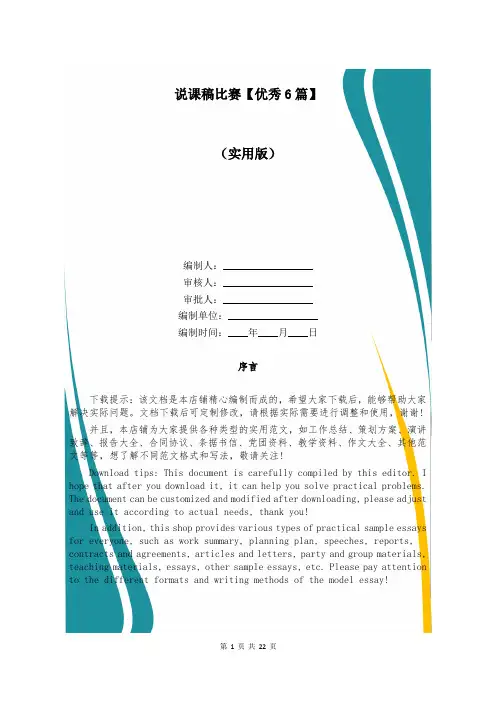
说课稿比赛【优秀6篇】(实用版)编制人:__________________审核人:__________________审批人:__________________编制单位:__________________编制时间:____年____月____日序言下载提示:该文档是本店铺精心编制而成的,希望大家下载后,能够帮助大家解决实际问题。
文档下载后可定制修改,请根据实际需要进行调整和使用,谢谢!并且,本店铺为大家提供各种类型的实用范文,如工作总结、策划方案、演讲致辞、报告大全、合同协议、条据书信、党团资料、教学资料、作文大全、其他范文等等,想了解不同范文格式和写法,敬请关注!Download tips: This document is carefully compiled by this editor. I hope that after you download it, it can help you solve practical problems. The document can be customized and modified after downloading, please adjust and use it according to actual needs, thank you!In addition, this shop provides various types of practical sample essays for everyone, such as work summary, planning plan, speeches, reports, contracts and agreements, articles and letters, party and group materials, teaching materials, essays, other sample essays, etc. Please pay attention to the different formats and writing methods of the model essay!说课稿比赛【优秀6篇】总结不仅仅是总结成绩,更重要的是为了研究经验,发现做好工作的规律,也可以找出工作失误的教训。

说课稿比赛优秀3篇高中语文教师说课比赛优秀说课稿篇一《想北平》说课稿华盛虹溪中学吕小恩说教材1、《想北平》是高中语文第三册“读本”中的一篇散文。
“大纲”规定:散文的教学重点是总体把握思想内容,体会作者情感,分析艺术手法,品味艺术语言。
《想北平》一文,描绘了一幅由山水、草木、街景、院落组成的“都市风俗画”,抒发了一个羁旅异乡的平民知识分子那份闲雅而热烈的“乡情”。
2、根据“大纲”要求与本文特点,我制定教学目标如下:知识目标:(1)理解本文思想内容;(2)学习本文“以情驭景”的散文笔法;(3)学习本文“对比”的手法;能力目标:(1)“美读”散文,品味本文“平民化的京味语言”;(2)提高“诵读-领悟-分析-归纳”的思维能力;情感目标;体会作者那份浓浓的“乡情”。
3、根据散文的教学特色和学生的学习状况,我将下列内容作为教学重点和难点。
教学重点:(1)的思想内容,体会作者那份浓浓的“乡情”;(2)提高“诵读-领悟-分析-归纳”的思维能力;教学难点;(1)学习本文“以情驭景”的散文笔法:(2)味本文“平民化的京味语言”;说教学1、评价一堂课的优劣的标准是多样的,我想有一点的不能被忽略的,那就是学生是否在老师的指引下真正动了起来,而成为学习的“主体”。
所以,我在课堂教学中设计教法如下:重点的突出方法:(1)根据本文“情感先行”,易于把握的特点,我打算让学生通过“美读”与“画直抒胸臆的句子”的学法,完成重点(1)的教学;(2)在文章写景部分(4――7节),每一节都写北平的一个特点(即安适、匀调、花多菜多果子多、接近大自然),且有中心词或中心句,是训练学生思维能力的好材料。
我设计通过“教师示范”的教法,学生“迁移模仿”的学法,来提高学生“诵读-领悟-分析-归纳”的思维能力。
这个过程体现了“教师为主导,学生为主体,能力训练为主线”的“三主”原则。
难点的突破方法:(1)本文“以情驭景”的写法是个教学难点,我计划通过与《故都的秋》比较学习来突破。
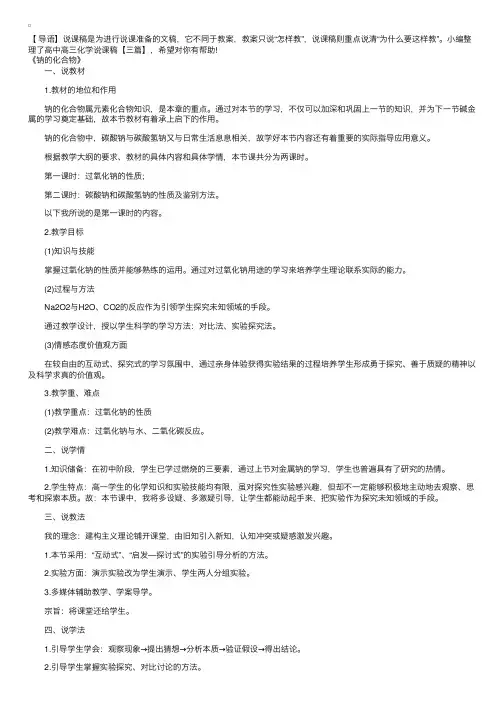
【导语】说课稿是为进⾏说课准备的⽂稿,它不同于教案,教案只说“怎样教”,说课稿则重点说清“为什么要这样教”。
⼩编整理了⾼中⾼三化学说课稿【三篇】,希望对你有帮助!《钠的化合物》 ⼀、说教材 1.教材的地位和作⽤ 钠的化合物属元素化合物知识,是本章的重点。
通过对本节的学习,不仅可以加深和巩固上⼀节的知识,并为下⼀节碱⾦属的学习奠定基础,故本节教材有着承上启下的作⽤。
钠的化合物中,碳酸钠与碳酸氢钠⼜与⽇常⽣活息息相关,故学好本节内容还有着重要的实际指导应⽤意义。
根据教学⼤纲的要求、教材的具体内容和具体学情,本节课共分为两课时。
第⼀课时:过氧化钠的性质; 第⼆课时:碳酸钠和碳酸氢钠的性质及鉴别⽅法。
以下我所说的是第⼀课时的内容。
2.教学⽬标 (1)知识与技能 掌握过氧化钠的性质并能够熟练的运⽤。
通过对过氧化钠⽤途的学习来培养学⽣理论联系实际的能⼒。
(2)过程与⽅法 Na2O2与H2O、CO2的反应作为引领学⽣探究未知领域的⼿段。
通过教学设计,授以学⽣科学的学习⽅法:对⽐法、实验探究法。
(3)情感态度价值观⽅⾯ 在较⾃由的互动式、探究式的学习氛围中,通过亲⾝体验获得实验结果的过程培养学⽣形成勇于探究、善于质疑的精神以及科学求真的价值观。
3.教学重、难点 (1)教学重点:过氧化钠的性质 (2)教学难点:过氧化钠与⽔、⼆氧化碳反应。
⼆、说学情 1.知识储备:在初中阶段,学⽣已学过燃烧的三要素,通过上节对⾦属钠的学习,学⽣也普遍具有了研究的热情。
2.学⽣特点:⾼⼀学⽣的化学知识和实验技能均有限,虽对探究性实验感兴趣,但却不⼀定能够积极地主动地去观察、思考和探索本质。
故:本节课中,我将多设疑、多激疑引导,让学⽣都能动起⼿来,把实验作为探究未知领域的⼿段。
三、说教法 我的理念:建构主义理论铺开课堂,由旧知引⼊新知,认知冲突或疑惑激发兴趣。
1.本节采⽤:“互动式”、“启发—探讨式”的实验引导分析的⽅法。
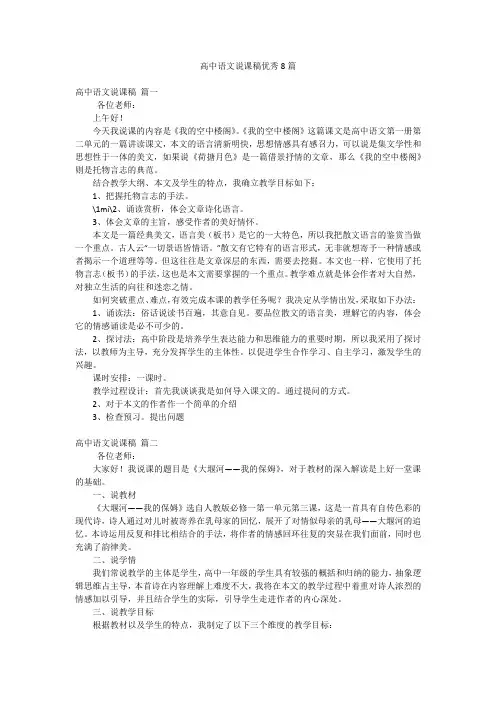
高中语文说课稿优秀8篇高中语文说课稿篇一各位老师:上午好!今天我说课的内容是《我的空中楼阁》。
《我的空中楼阁》这篇课文是高中语文第一册第二单元的一篇讲读课文,本文的语言清新明快,思想情感具有感召力,可以说是集文学性和思想性于一体的美文,如果说《荷搪月色》是一篇借景抒情的文章,那么《我的空中楼阁》则是托物言志的典范。
结合教学大纲、本文及学生的特点,我确立教学目标如下:1、把握托物言志的手法。
\1mi\2、诵读赏析,体会文章诗化语言。
3、体会文章的主旨,感受作者的美好情怀。
本文是一篇经典美文,语言美(板书)是它的一大特色,所以我把散文语言的鉴赏当做一个重点。
古人云“一切景语皆情语。
”散文有它特有的语言形式,无非就想寄予一种情感或者揭示一个道理等等。
但这往往是文章深层的东西,需要去挖掘。
本文也一样,它使用了托物言志(板书)的手法,这也是本文需要掌握的一个重点。
教学难点就是体会作者对大自然,对独立生活的向往和迷恋之情。
如何突破重点、难点,有效完成本课的教学任务呢?我决定从学情出发,采取如下办法:1、诵读法:俗话说读书百遍,其意自见。
要品位散文的语言美,理解它的内容,体会它的情感诵读是必不可少的。
2、探讨法:高中阶段是培养学生表达能力和思维能力的重要时期,所以我采用了探讨法,以教师为主导,充分发挥学生的主体性。
以促进学生合作学习、自主学习,激发学生的兴趣。
课时安排:一课时。
教学过程设计:首先我谈谈我是如何导入课文的。
通过提问的方式。
2、对于本文的作者作一个简单的介绍3、检查预习。
提出问题高中语文说课稿篇二各位老师:大家好!我说课的题目是《大堰河——我的保姆》,对于教材的深入解读是上好一堂课的基础。
一、说教材《大堰河——我的保姆》选自人教版必修一第一单元第三课,这是一首具有自传色彩的现代诗,诗人通过对儿时被寄养在乳母家的回忆,展开了对情似母亲的乳母——大堰河的追忆。
本诗运用反复和排比相结合的手法,将作者的情感回环往复的突显在我们面前,同时也充满了韵律美。
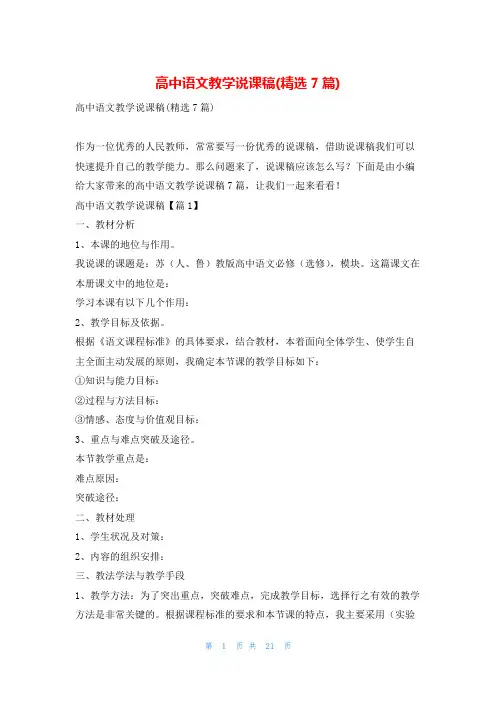
高中语文教学说课稿(精选7篇)高中语文教学说课稿(精选7篇)作为一位优秀的人民教师,常常要写一份优秀的说课稿,借助说课稿我们可以快速提升自己的教学能力。
那么问题来了,说课稿应该怎么写?下面是由小编给大家带来的高中语文教学说课稿7篇,让我们一起来看看!高中语文教学说课稿【篇1】一、教材分析1、本课的地位与作用。
我说课的课题是:苏(人、鲁)教版高中语文必修(选修),模块。
这篇课文在本册课文中的地位是:学习本课有以下几个作用:2、教学目标及依据。
根据《语文课程标准》的具体要求,结合教材,本着面向全体学生、使学生自主全面主动发展的原则,我确定本节课的教学目标如下:①知识与能力目标:②过程与方法目标:③情感、态度与价值观目标:3、重点与难点突破及途径。
本节教学重点是:难点原因:突破途径:二、教材处理1、学生状况及对策:2、内容的组织安排:三、教法学法与教学手段1、教学方法:为了突出重点,突破难点,完成教学目标,选择行之有效的教学方法是非常关键的。
根据课程标准的要求和本节课的特点,我主要采用(实验探究法、控制变量法、知识迁移法、建立模型法、认识类比法、分组讨论法、问题讨论法、教师导学法、学生自学法)倡导自主、合作、探究的学习方式,关注学生的个体差异和不同的学习需求,爱护学生的好奇心、求知欲。
这样既充分调动了学生学习的积极性,又培养了学生的观察、分析和思维能力和创新意识。
2、学习方法古人主张:“授人鱼,不如授人以渔”,在全面推进课程改革的今天,课堂上不仅要传授文化知识,更重要的是教给学生科学的学习方法,为他们今后继续教育或终身教育打下基础,所以在教学过程中我注意渗透学生学法指导,如:(自学法、实验探究法、控制变量法、知识迁移法、模型法、类比法、由简到繁法、动手动脑)3、教学手段:运用多媒体、板书、录音机等其作用是:四、教学程序设计为了完成本节的教学目标,我是这样安排的:第一环节:(分钟)l导入……激发兴趣,(激发求知欲)“兴趣是最好的老师”,求知欲同样是学生积极思维、探索知识的内在动力。
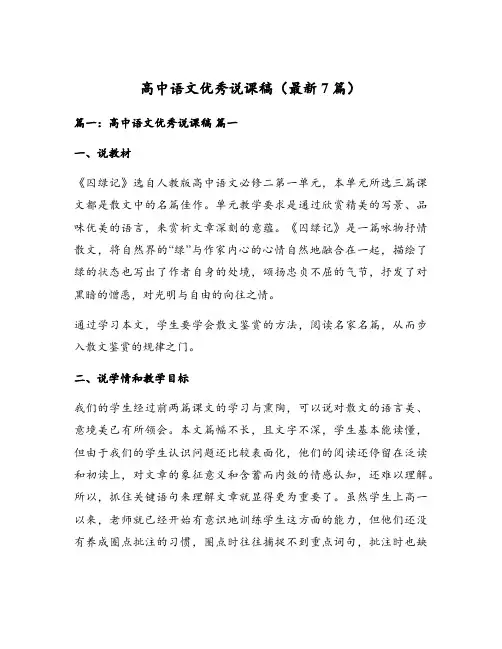
高中语文优秀说课稿(最新7篇)篇一:高中语文优秀说课稿篇一一、说教材《囚绿记》选自人教版高中语文必修二第一单元,本单元所选三篇课文都是散文中的名篇佳作。
单元教学要求是通过欣赏精美的写景、品味优美的语言,来赏析文章深刻的意蕴。
《囚绿记》是一篇咏物抒情散文,将自然界的“绿”与作家内心的心情自然地融合在一起,描绘了绿的状态也写出了作者自身的处境,颂扬忠贞不屈的气节,抒发了对黑暗的憎恶,对光明与自由的向往之情。
通过学习本文,学生要学会散文鉴赏的方法,阅读名家名篇,从而步入散文鉴赏的规律之门。
二、说学情和教学目标我们的学生经过前两篇课文的学习与熏陶,可以说对散文的语言美、意境美已有所领会。
本文篇幅不长,且文字不深,学生基本能读懂,但由于我们的学生认识问题还比较表面化,他们的阅读还停留在泛读和初读上,对文章的象征意义和含蓄而内敛的情感认知,还难以理解。
所以,抓住关键语句来理解文章就显得更为重要了。
虽然学生上高一以来,老师就已经开始有意识地训练学生这方面的能力,但他们还没有养成圈点批注的习惯,圈点时往往捕捉不到重点词句,批注时也缺少个性表现,语言表述也难以做到准确、完整。
还需要老师的点拨和引导。
依据以上的分析以及新课标要求,制定教学目标、重点、难点如下11、知识与能力目标(1)了解作者的身世,加深对本文内涵的理解。
(2)指导学生筛选出关键语句,学会运用圈点批注的读文方法来把握语句的重要信息,体会象征意义和作者的感情。
2、过程与方法目标(1)通过朗读的方法,使学生能够复述作者囚绿的经过,达到把握全文整体脉络的目的。
(2)运用启发式教学,引导学生逐步深入课文,使学生能够自主地体会作者的思想感情。
3、情感态度与价值观:联系当时的社会环境,明确作者在抒写对绿的挚爱之情中,表达对生命的爱,对光明、自由的向往,对坚贞不屈的抗敌精神的歌颂。
教学重点:学会圈点批注,理解语句含义,理解“绿”的象征意义,达到思想上的升华【教学难点】:理解作者含蓄的以一棵常春藤作为民族精神的象征,歌颂中华民族不畏、追求自由光明的忠魂洁魄,寄托了他对祖国自由、光明、复兴的热切期盼。

高中英语说课稿(合集三篇)【篇一】高中英语说课稿Hello, everyone. I’m glad to be here to give my lesson plan presentation. The lesson plan I’m going to talk about is the reading part from NSECS book 1 unit 1 Friendship. Now, I’d like to explain how to teach and why to do so from the following aspects: the analysis of teaching material and learning condition, the teaching objectives, the teaching method and teaching aids, the teaching procedures, and the blackboard design.First, I’d like to talk about the analysis of t eaching material and learning condition.The title of the text is “Anne’s Best Friend”. It mainly talks about a Jewish girl, Anne, who treated her diary as her best friend when she and her family hid in a shelter to escape from the killing of Nazis. The text has tow parts, the first part is about the background of Anne’s diary, and the second part is about the content of Anne’s diary. The key point of the text is that students can use different kind of reading skills like prediction, scanning and skimming to get good understanding of the text. The difficult pointis that students can summarize the main idea of the whole text and each paragraph.As for the students, they are in grade 9 in high school, and they have learned English for more than 7 years. They have a certain vocabulary store, while they lack the training of reading skills. They are interested in the topic of friendship because they attach much importance to friendship. And they can make some discussion in English.According to the analysis of teaching material and learning condition, I make out the following teaching objectives.First, language skills: students can use reading skills like prediction, skimming and scanning to read the text.Second, language knowledge: students can learn some new words and new phrases, such as power, on purpose, in order to, etc. and students can be familiar with the topic of friendship.Third, learning strategy: students will learn to study and solve problems by cooperation and communication.Fourth, affective objectives: students will value friendship more and cherish what they have.Last, cultural awareness: students will know more knowledge about the history of World War Ⅱ, especially the suffering of Jewish people during the war.Then, I’ll talk about the teaching method and teaching aids. I adopt communicative approach. And the teaching aids are blackboard and PPT.Now, I will focus on the teaching procedures. There are 4 steps. Step 1 is warming up. It will cost 3 minutes. In this part, I will show students an English song “Forever friend”. Before listening, I will ask students to think about the question “What’s the song about” so that they will listen to the song with purpose. After they finish the listening, they will know that the song is about friendship. It will naturally lead in the topic of the text. What’s more, students are interested in listening to music, the song will arouse students interest and activate the class atmosphere.Step 2 is pre-reading, it will cost 5 minutes. First, I will ask students to read the title of the text and ask them “Do you knowAnne Who is she” if students don’t know, I will tell them that Anne is a Jewish girl who survived in the World War Ⅱand I will talk about the suffering of Jewish people during the war with some related pictures. After students have the background knowledge of the text, I will ask them to look at the title and the picture of the text to predict the content of the text. The purpose of prediction is to make students read the text more carefully during the reading process. They will concentrate more to check their prediction so that they can get their mind closer to the theme of the text.Step 3 is while reading. It will cost 25 minutes. There are there activities.In activity 1, I will ask students to skim the text to get the main idea of the text and each paragraph. Because it’s a little difficult for students to summarize the main idea, I will give them some multiple choices to choose, it will reduce the degree of difficulty. The purpose of this activity is to train students’ reading skill of skimming, and they can get the general idea of the text.In activity 2, I will ask students to scan the text to fill in some blanks. The purpose of this acti vity is to train students’ reading skill of scanning, and they can get some detailed information of the text.Activity 3 is close reading. In this part, I will first explain some new expressions that may cause difficulty in students’ comprehension, such as go through, on purpose, in order to, etc. so that they read the text smoothly. Then I will ask students to answer the questions in exercise 2. After answering these questions, students will have a better understanding of the whole text. Next, Iwill ask students to work in pairs to use some adjectives to describe Anne’s feelings as she was looking out at the night sky. Then I will ask some students to come to the blackboard to write the adjectives. After this activity, students will have a better understanding of Anne’s feelings.Step 4 is post reading. It will cost 12 minutes. In this part, I will hold a group discussion. I will set a situation to students. That is “imagine you have to go into hiding like Anne and her family, what will you miss mos t Why” I will ask students to work in 4 to have a discussion. After discussion, I will ask some students to report their groups’ opinions and then I will write them on the blackboard. The purpose of this activity is to cultivate students’ spirit of cooperation. And after the discussion, students will learn to cherish what they have.Then, I will talk about the homework. I will ask students to write a short passage about what they will miss most and why based on the former discussion in class.Ok, now, please look at here, this is my blackboard design.miss reasonsThis is all my lesson plan presentation, thank you very much!【篇二】高中英语说课稿Good morning, everyone! I’m glad to be here to give my lesson plan presentation. The lesson plan I am going to talk about is the reading part of Unit 4 Wildlife Protection in the book NSEFC BOOK1. Now I’ll explain my lesson plan from the following aspects——analysis of teaching material, learning condition, teaching objectives, important and difficult points, teaching methods, teaching procure and blackboard design.Analysis of teaching material and learning conditionFirst, let’s come to the analysis of teaching material. The reading material is entitled How Daisy Learned to Help Wildlife. It talks about how Daisy learned the importance of wildlife protection through her communication with some animals in her dream. It is closely connected with this unit’s topic——the importance ofwildlife protection. The passage is clearly organized by Daisy’s 3 trips in which she communicates with several endangered animals, and there are not so much new words in this passageNow let’s move on to the analysis of learning condition, students must be very familiar with the topic and interested in all kinds of animals. Students have acquired the basic reading skills, such as skimming, scanning, etc to deal with different reading tasks, and they can do some discussion in English. However, they are notfamiliar with the organization WWF mentioned in the passage, notclea r with the author’s purposes of writing some sentences, and they may find it difficult to deal with some real problems by themselves concerning with wildlife protection.Teaching objectivesBased on the analyses of the teaching material and the learning condition, I will show you the teaching objectives.(1) Language Skills:1. Students can get the needed information about Daisy’s trip by applying different reading skills.2. Students can summarize the main ideas of each paragraph through skimming.3. Students can analyze the author’s purpose of writing sentences like “No rainforest, no animals, no drugs” and “And there are always WWF.”(2) Language Knowledge:1. Students can know more about why some animals are in danger and how to protect them.2. Students can know how to use the new words, such as mercy, importance, contain, etc.(3) Affective objectives:Students can realize the importance of wildlife protection.(4) Culture awareness:Students can know something about the organization WWF.(5) Learning strategy:1. Students can improve their communication strategy by discussing with classmates about protecting animals.2. Students can refer to the Internet to know more about wildlife protection.Key point and difficult points:Key points:(1) Students can improve their reading skills, such as summarizing, skimming, scanning, etc.(2)Students can get the main idea of the passage.(3) Students can know how to use the new words in the passage.Difficult Points:1. Students can summarize the main ideas of each paragraph.2. Students can get the implied meaning of some sentences in the passage.Teaching methodsAs for teaching methods, I’ll follow the interactive model to deal with the reading material and communicative approach to put what the students have learned into use.Teaching procedure:Then I’ll talk about the most important part of my presentation——teaching procedure.Warming-upThe first step is warming-up. It will cost 3 minutes. First, I’ll show my students a short clip of video about the endangered wildlife. Then, I’ll ask the students to name the endangered animals in it together with me and list more. This step is aimed to arise the studen ts’ interest and get the students familiar with the topic——wildlife.Pre-readingThe second step is pre-reading. It will cost about 5 minutes with 2 activities. In the first activity, I’ll introduce something about the organization WWF to the students. The second activity is to ask students to give their reasons to the question “Why are some animals in danger”. The purpose of these activities is to let students have the background knowledge of the passage and get interested in reading the passage. And it is also in this step some new words like fur, protect, affect will be taught.While-readingThe third step is while-reading. It consists of 3 activities which will be finished in 20 minutes.The first activity is skimming. It will cost about 5 minutes.I’ll ask the students to skim the passage and work out the main ideas of each paragraph by themselves. It is the difficult point for the students, so I’ll give them hints such as key words or some answers to choose when necessary to help them to do the summarization. The purpose is the improve students’ readingability——skimming and let them get the main ideas of the passage. The second activity is scanning. It will cost about 3 minutes.I’ll ask the students to read fast and do some True or False questions. The purpose of it is to get students know the detailed information about Daisy’s trip and wildlife protection and improve their scanning ability.The third activity is close reading. It will cost about 12 minutes. Students will be asked to read the passage paragraph by paragraph and fill in the form the needed information——name of the animals in Daisy’s trips, their situation, and result. Then I’ll ask the students questions: “What does the author want to tell us from the first para graph”, “How the government help protect the elephants”, and “How do you understand the sentences ‘No rainforest, no animals, no drugs.’ and ‘and there was always WWF.’”. These 3 questions involve some implied meanings which may be difficult for students t o work out, so I’ll give some key words as hints for them or ask some other related questions to guide them to work out the answers. The purpose of this activity is to make the students fully understand the reading material and try to analyze the author’s purpose of writing some sentences. And in these 3 activities, I can also teach students some new words like carpet, respond, powerful, etc.Post-readingThe fourth step is post-reading. It will cost about 10 minutes.I’ll ask the students to form g roups of 4 and do the discussion based on the questions on page 27, and they can refer to the reading material to work out these answers. After the discussion, I’ll ask some students to report their answers, especially how to protect theendangered animals.HomeworkThe last step is homework. It will take about 2 minutes. The homework is to write a short passage entitled “How to Protect Wildlife”. They can surf the internet and try to find more ways about wildlife protection.Well, this is the b lackboard design. In the middle, it’s the form for students to fill in, and on the 2 sides, there are the new words in the passage. Some of them, as I’ve mentioned, are taught in pre-reading. Most of them is taught in third-step while-reading.That’s a ll for my lesson plan presentation. Thank you for your attention. Thank you!Unit 4 How Daisy Learned to Help Wildlifeprotect Animal Situation Result carpetfur Para 1 antelope being hunt decrease powerfulaffect Para 2 respondin relief Para 3 importancemosquitoes appreciate【篇三】高中英语说课稿 Reading Part in NSEFC Module 1 Unit1 Friendship——Anne’s Best FriendHello, everyone. I’m …. I’m very glad to be here to present my lesson plan. The lesson I’m going to talk about is the readi ng in NSEFC module 1 Unit1 Friendship. The title of the reading material is Anne’s Best Friend. I will present how to teach it and the reasons for doing so in the following aspects: the analyses of teaching material and learning condition, teaching objectives,the important and difficult points, teaching method, teaching procedures and blackboard notes.First of all, I’d like to analyze the teaching material. The text is about the story of a Jewish girl who treated her diary as her best friend when she was hiding away from the Nazi during the Second World War. It mainly consists of two parts; the first part is the introduction of Anne and her diary named Kitty. The second part is a diary entry written by Anne in the form of letter addressed to Kitty. The text is a bit long and there are a lot of new words and expressions in it, especially in the letter.Now, let’s move on to the analysis of learning conditions. The students are in grade1 in the senior school, they have achieved certain English level so they have no problem in comprehending the text and get the basic idea. They have learned the Second World War so their previous knowledge about it can lessen their difficulty of comprehension. But most of them maybe are not very familiar with the sufferings of the Jewish people during the war. I will introduce the related information rightly in the beginning of the lesson so as to prepare the students for the deep study of the text.Based on the analyses of the teaching material and the learning condit ion, I’d like to propose the teaching objectives and the important and difficult points.(1) language skillSs will improve their reading skills by training some of the reading skills, such as skimming, scanning. It is the important point of this lesson.Ss will improve their writing skills by writing a letter to their friend. It is the difficult point of this lesson.(2) language knowledgeSs will master most of the new words and expressions in the text.This is the important point of this lesson.Ss will know the direct speech and indirect speech.(3) Affective objectivesSs will have a deeper understanding of the friendship so they will cherish their friends more than ever before. Ss will realize the cruelty of the war and the importance of the peace.(4) Culture awarenessSs will know more about the Second World War, especially the persecution Jewish people suffered from the Nazi.(5) Learning strategySs will cultivate their ability of individual learning and cooperative learning.As for the teaching methods, I mainly adopt audio-visual teaching method in the lead-in. During the reading process, I follow the top down modal to help the Ss to learn the text.Now, here comes the most important part of my presentation—teaching procedures. I’ll finish the lesson in 4 steps within 45 minutes. They are:Step1: Lead-in.Step2:Pre-readingStep3: While reading.Step 4: Post-reading.At the end of the lesson, I will present the homework.Now, let me introduce them step by step in details.The first step is lead-in. It will cost 7minutes. At the beginning of the lesson, I will play a short video clip which is about the sufferings of the Jewish people during the Second World War. From it, Ss will know that many Jewish people were caught and killed by Naziin the camps, so others had to hide away. Then I will ask Ss what they needed most when in hiding. Ss may come up with the food, clothes and so on. I will give them some hint and they will realize that friends are also very important for them. Then it will be very natural for me to tell them than there was a girl called Anne who had a very good friend during the hard time. In this process, I will introduce them three new words, they are: German, Netherlands, go through. In this step, I adopt audio-visual teaching method, because the pictures and sounds serves better to activate the Ss. So I use the video to attract the Ss’ attention. What’s more, the introduction of Jewish people’s sufferi ng by this video clip provides them with the background information of this text.Then I will move on to the second step---pre-reading. It will only cost 3 minutes. The Ss are required to guess who Anne’s best friend is and what happened to them by looking at the title and the pictures. Then I will ask several Ss to say their predictions but I will not tell them the answer directly in this step. Although not all the Ss can get the right answer, their mind can get closer to the theme of the text by predicting. So, later, when they read the passage they will concentrate more on it to check their predictions. After pre-reading, we will move on to the while-reading step which costs 22 minutes in total. There are 5 activities, the first three of which deals with the first two paragraphs of the text which is also the first part of the text. And the last two activities deal with the second part.The first activity is skimming. Ss are expected to skim the first part of text to work out the main idea. But as there is no topic sentence in this part, it is a bit difficult for students to tell themain idea with their own words. So I will present a multiple choice which covers the main idea of the text for them to choose from. This reduces the difficulty of th e task as well as the Ss’ anxiety.After getting the main idea, we will do another activity, namely, scanning. Ss are expected to scan the text to find some specific information, such as the place and the time of the story, etc. Ss can develop the ability of information gathering and independent learning.After skimming and scanning, we will do the third activity of this step---close reading. I will help Ss learn the passage paragraph by paragraph. For the first paragraph, I will ask some questions like “According to Anne, what kind of person should a true friend be” The answer to these questions cannot be taken directly from the text. Ss need to reorganize the sentences. If they can answer these questions, it means they have understood this paragraph. Then we will learn the second paragraph. For this one, I will ask one question “What did Anne say about her diary” Ss may answer it by theoriginal words said by Anne, I will catch this opportunity to tell them they change the direct speech into the indirect speech. But I will not go deeper, because they will learn this language point next period, so a simple introduction is ok.This is all for the first part of the text. Then we will start to learn the letter. There are two activities for this part. The first one is skimming,they should skim the letter for the main idea first and I will present a multiple choice for them to choose from. Them we will learn the letter in detail in the next activity. For the first paragraph of the letter, I will ask them to find out the changing of Anne’s attitudes toward nature. Ss can find out that before hidingaway, she paid no attention to the nature while she grew crazy about it when hiding. Then I will ask them to find out the reason. As for the second paragraph, Anne narrates two experiences of longing to get close to nature. So firstly, I will ask them to pick out the time of the experience and then we will study her feelings in the process. Of cause, we will learn some new word here, such as on purpose, at dusk and so on.After the while-reading, comes the post-reading step. It will cost 12 minutes. In this step, I will firstly ask Ss if they have to go into hiding like Anne and her family, what they would like to say to their friends. Ss will talk in groups of four and share their ideas with each other. During the discussion, the Ss will be stimulated and also know the importance of friendship. It servers to make the Ss be prepared for the next activity---writing. After the discussion, the Ss shall write a letter to their friends individually. As they have talked about what they want to say to their friends, the difficulty of the writing is lowered because they have something to say. Ss are expected to write just a draft, for the time is limited.Lastly, I will give Ss the homework. It will only cost one minute. Ss should not only review the new words and expressions of the text, but also polish their letter after class.That’s all for the teaching procedure. And here is my blackboard note. On the right side, there are the words and expressions. In the middle, there are some points of the comprehension of the text.That all for my lesson plan presentation thanks for your attention.Blackboard notes:Unit 1. Anne’s Best FriendBefore: paid no attention to it reasonsWhile: go crazy about itGermanNetherlandGo throughSet downA series of。
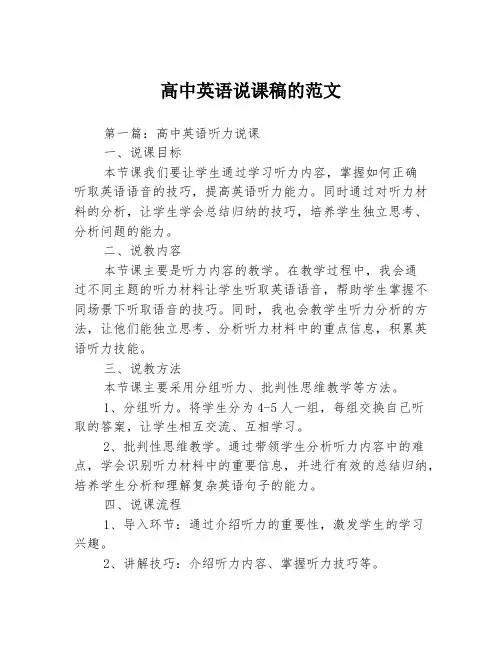
高中英语说课稿的范文第一篇:高中英语听力说课一、说课目标本节课我们要让学生通过学习听力内容,掌握如何正确听取英语语音的技巧,提高英语听力能力。
同时通过对听力材料的分析,让学生学会总结归纳的技巧,培养学生独立思考、分析问题的能力。
二、说教内容本节课主要是听力内容的教学。
在教学过程中,我会通过不同主题的听力材料让学生听取英语语音,帮助学生掌握不同场景下听取语音的技巧。
同时,我也会教学生听力分析的方法,让他们能独立思考、分析听力材料中的重点信息,积累英语听力技能。
三、说教方法本节课主要采用分组听力、批判性思维教学等方法。
1、分组听力。
将学生分为4-5人一组,每组交换自己听取的答案,让学生相互交流、互相学习。
2、批判性思维教学。
通过带领学生分析听力内容中的难点,学会识别听力材料中的重要信息,并进行有效的总结归纳,培养学生分析和理解复杂英语句子的能力。
四、说课流程1、导入环节:通过介绍听力的重要性,激发学生的学习兴趣。
2、讲解技巧:介绍听力内容、掌握听力技巧等。
3、分组听力:让学生进行分组听力。
4、批判性思维教学:通过带领学生分析听力内容中的难点,学会识别听力材料中的重要信息,并进行有效的总结归纳,培养学生分析和理解复杂英语句子的能力。
5、总结巩固:通过总结教学内容,帮助学生深化英语听力技能。
五、说教体会本节课主要是针对英语听力技能进行教学,通过讲解技巧、分组听力等具体手段,情于激发学生的英语学习兴趣,提高学生的英语听力能力。
同时,本课程也通过批判性思维教学,帮助学生深度理解听力材料中的难点,培养学生分析和总结归纳的能力。
教师应注意在教学中注重不同层次学生的教学差异,针对学生存在的问题进行及时的分析和解决,确保教学效果最大化。
高中语文说课稿(15篇)高中语文说课稿1各位领导专家老师:我是,我今天非常荣幸有这么一个展示的机会,谢谢你们!希望得到你们的指导.我说课的题目是《花未眠》,我说课的内容分别是说教材,说教学法,教学程序设计等.《花未眠》是人教版高中语文第一册第二单元第四篇课文,是曰本作家诺贝尔文学奖获得者川端康成的一篇关于美和审美的哲理散文.现就教材,教法,学法及教学过程四个方面加以说明.一,说教材:1,教材简析:本单元设计的目的是通过阅读现当代散文,学会在总体把握散文思想内容和艺术的基础上,感受散文中的自我,品味散文的语言.学会整体把握文章思想内容,学会体会散文语言的美感.《花未眠》是第一册第二单元的最后一篇课文,文章以发现海棠花未眠写起,从三个方面阐述:自然美是无限的,人感受美是有限的;美是邂逅所得,亲近所得;重视自然美,崇尚写实精神.本文由于是哲理散文,加上学生对艺术欣赏的能力尚待形成,因此内容理解较难.如何把难理解的文章深入浅出的讲解好,使学生能较好的理解体会是教学设计的关键所在. 2,教学目标:根据本单元教学对学生知识和能力的要求,以及本课特点,特制定两个教学目标:(1)情感目标,理解本文主旨,让学生建立起感受生活美的意识.(2)知识与能力目标,学会整体把握文章内容,品味散文语言.能从现实生活中去发现美,感受美,学会创造美.3,教学重点难点:根据教学目标的设定,本课教学的重点难点就确定为:理解本文主旨与鉴赏本文语言,理解重点句子的含义.二,说教法:本文教学重点是理解主旨和鉴赏语言,因此教学中让学生整体把握文章是关键.运用前几篇课文所学的提要钩玄的方法,学会勾画圈点重要的句子,抓住关键句子理解主旨.采用重点段落重点阅读的方法进行,让学生能尽快的抓住关键.同时也采用问题激趣讨论法,使学生能自主地探讨问题.三,说学法:本课内容较难理解,特别是有些哲理性较强,隐含着作者深切感受的语句如:"它盛放,含有一种哀伤的美"等,理解较困难,因此,课堂上要激发学生的探讨兴趣,让学生自由的发表意见,自主合作的探讨问题.四,说教学过程:1,导语设计:以一组鲜花图片展示其自然的美,让学生自由发表观后感受,引起学生对自然美的注意和欣赏.此设计直接调动学生的审美情感.然后由苏轼的"只恐夜深花睡去,故烧高烛照红妆"的佳句引入川端康成的《花未眠》,出示题目.2,简介作者川端康成.川端康成(1899—1972),日本小说家,散文家.幼年时父母相继去世,分别由外祖父和舅父托养.1924年从东京帝国大学毕业后,开始了作家生涯.小说《伊豆的舞女》(1925)奠定了其在日本文坛的地位.代表作有《雪国》(1937),《千只鹤》(1951),《古都》(1957)等.它们"以丰富的感情,高超的技巧,表现了日本人的内心精华",川端康成因此获得1968年诺贝尔文学奖,他是继泰戈尔之后,第二个获此殊荣的东方作家.川端康成继承了大和民族文学的古典美,并使其升华到美学境地.在文学领域中,他既是美的追求者,更是美的获得者和传播者.由于受佛教影响较深,故其作品常带有消极悲观情调.荣誉也不能解脱他思想的颓废和空虚,1972年4月16日,他终于口含煤气管自杀,终年73岁.3,初步理解文章主旨:首先指定学生朗读第三段内容,然后思考:看看作者由花未眠想到了什么或者说有什么感悟接着让学生评价是否同意这个观点能否说说他们所能感受的自然的美通过这个过程的阅读,学生就能整体把握到文章的一个观点:自然的美是无限的,人感受到的美是有限的.同时也通过讨论让学生进一步明确我们身边很多事物是非常美的,只是我们平常没有留心,让学生明白平时要留心生活中的自然美.4,思考作者又是在怎样的环境中发现海棠花的美的呢学生通过阅读课文学会在文中找到答案:"凌晨四点起来,我一个人凝视着海棠花,更觉得它美极了.""我之发现花未眠,大概也是由于我独自住在旅馆里,凌晨四时就醒来的缘故吧."然后教师小结:作者能够发现司空见惯的海棠花的美,原因有二:一为"静";二为"孤独".学生通过这一环节的自学,就去把文章的第二观点"美是邂逅所得,是亲近所得"找到并有所理解了.5,出示文中出现的有关艺术作品的图片,让学生直观感受,思考对于这些艺术作品作者持什么态度它们有什么共同点借此让学生再去读文章关于这些内容的段落,明白这些艺术作品都是和自然美的完美结合,能够给人更多的美感,而真正反映自然美的艺术作品更能引起欣赏者美的共鸣,能够提高人对美的感受能力.6,通过这几个环节的学习,学生对内容有了全面的了解,教师此时再加以总结,学生就对内容有了更明确的理解.教师小结:作者由未眠之海棠写起,阐述了自己对美和审美的三个观点,即:自然的美是无限的,人感受到的美却是有限的;美是邂逅所提,是亲近所得;契合自然美的艺术品能提高人对美的感受能力.这三个观点其实就是要告诉我们要发现存在的美,感受发现的美,创造有所发现的美.7,学生对内容有了较深刻的理解,然后再进行迁移拓展就顺理成章了.设计一个迁移训练,让学生从读到写,出示一个名家描写自然美的语段,朱自清《荷塘月色》;出示一幅清幽的山水图,也请学生把自己感受到的自然美用三五句话把它描述出来.8,最后一个环节就是品味文中优美的句子的含义这个环节放手让学生自由讨论,你认为优美的句子或是不太好理解的句子.教师可举例引导如:(1)它盛放,含有一种哀伤的美.为什么说盛放的海棠花的美含有一种"哀伤"明确:海棠花在夜间是不眠的,然而其盛放的美却无人发现,无人欣赏,所以说含有一种哀伤的美.(2)如果说,一朵花很美;那么我有时就会不由自主地自语道:要活下去!这句话背后有什么隐蒇义明确:①一个微小的生命都要努力展现自己的美,作为人更要勇敢活下去.②人生是一个学习的过程,也是一个不断在有意或无意间错过一些美好事物的过程.我们可能错过了美的景色,美的音乐,错过了山上那从没有看过一眼的野花和小草,错过了从我们身边流淌过的清澈的小溪,但只要坚韧地活着,就能不断发现美.③我们要用毕生的不懈追求使有限的感受美的能力接近无限的自然美.9,最后教师总结:通过学习,我们可以发现,虽然这是一篇谈论美学问题的文章,可是它本身也是美的.其实美无处不在,美就在我们的身边.我们应该感谢川端康成,他告诉我们只要细心地去寻找,用心地去观察,我们就可以发现美,感受美并能创造美.那就让我们以这种美好的心态去拥抱我们灿烂的明天吧!高中语文说课稿2一说教材《囚绿记》选自人教版高中语文必修二第一单元,本单元所选三篇课文都是散文中的名篇佳作。
【导语】“说课”是教学研究、教学交流和教学探讨的⼀种新的教学研究形式。
为⼤家准备了以下内容,希望对⼤家有帮助。
1.精选⾼中语⽂说课稿 ⼀、⽬的: 1、了解朦胧诗的特点; 2、把握诗歌的意象,体味意境,理解诗⼈的思想感情; 3、了解诗⼈的情感脉络。
⼆、说课过程: 第⼀部分: 第⼀节:“我和春天”“和你”“和更多的⼈”点明作者和春天融合在⼀起,同时照应题⽬“我们⼀起”;“海洋冰块”船开始起航告诉我们冬天渐逝;这时,我们“呼唤风”“使⼤地上所有的⼩树⽊都涨满绿⾊的帆”作者盼望春天的到来。
第⼆节:当丰收的“果⼦”被“狂风”“击落”时,也是“种⼦”“撒遍⼤地”时,种⼦的“沉默”是为了“今天”的“歌唱”,“今天”意指上⽂的春天,也点明作者盼望春天的到来。
春天到底怎样呢? 第三节:此节作者写了那些意象?他们的特点是什么? ⽟兰花(洁⽩的⼼向蓝天打开)、迎春花(繁星似的到处闪烁)、阳光(追逐着)、鸟⼉(牵动着)、紫丁⾹(像影⼦⼀样在⾝后晃动)等 他们总的特征是?⽣机勃勃、欢快祥和、繁花似锦。
体现作者的感情是?喜爱、赞美。
“紫丁⾹像影⼦⼀样在⾝后晃动 春天正迎着我们⾛来,献上更多的花朵”⽤⽐喻、拟⼈⼿法进⼀步表达对春天的赞美和盼望。
第⼆部分: 这⼀部分叙述主体由第⼀部分的“我”变为“你”,第⼆⼈称的运⽤拉近了叙述主体与诗中“你”的距离。
由第⼀部分我们知道作者极⼒赞美春天,渴盼春天的到来。
所以这⼀部分的“你”应该指春天。
从⽂中找出体现春天特点的词语、句⼦。
热情、开朗;像四⽉的阳光;善良;憎恨⿊暗,甚⾄阴影;清澈地对待别⼈(即真诚的对待别⼈)。
“爱情的震颤,庄稼的波涛,⾦属的鸣响”从触觉视觉听觉表明你对美好事物的追求。
“你将⼀年⼜⼀年把这鲜红的果⼦挂满枝头 让善良的⼈们摘去”这⾥的“你”紧承上⽂,应该指“⼀颗鲜红的浆果”般的“清澈地对待别⼈”的⼼,“让善良的⼈们摘去”表达出“你”期待更多的⼈像你⼀样真诚的对待别⼈。
【导语】⼀堂好地英语课,肯定少不了⼀个优秀地说课稿,那么要怎么写⼀个优秀地英语说课稿呢?⽆忧考准备了以下内容,供⼤家参考!篇⼀ Good afternoon, everyone, It’s my great pleasure to be here sharing my lesson withyou.The content of my lesson is Senior English for China Book1B Unit 16 Scientists at work. I’ll be ready to begin this lesson from five parts. Analysis of the teaching material, the teaching methods, the studying methods, the teaching procedure,and Blackboard design.First, let me talk about the teaching material. Part 1 Teaching Material: This unit is about science and scientists. By studying of this unit, we’ll Enable the students to know the serious attitude towards science and develop the interest in science. At the same time ,Let the students learn how to give instructions. this lesson plays an important part in the English teaching in this unit.This is an important lesson in Book One. From this lesson, it starts asking the Ss to grasp contents of each passage. Therefore, this lesson is in the important position of the teaching material. If the Ss can learn it well, it will be helpful to make the Ss learn the rest of this unit.As we all know ,reading belongs to the input during the process of the language learning. The input has great effect on output , such as speaking and writing . According to the new standard curriculum and the syllabus (新课程标准和教学 ⼤纲), after studying the teaching material and analyzing the rule of children’s growing of mind,I think the teaching aims are the followings: 1.Knowledge objects: a)The Ss can hear, read, and use the main sentence patterns b)The Ss can understand the content of the lesson. c)The Ss can use the patterns to express their thoughts in the proper situation. 2.Ability objects: (1) To develop the Ss’ abilities of listening, speaking, reading and writing. (2) To train the Ss’ ability of working in pairs. (3) To Improve the student’s reading ability, especially their skimming and scanning ability. 3.Emotion or moral objects: a)By completing the task,the Ss increase their interest and set up self-confidence in science; b)Teach the Ss what is “science”, put the moral education in the language study. now,let’s come to the Important points and the Difficult points. Well, how to achieve the teaching objects better, how to stress the important points and break through the difficult points? As is known to us all,The modern teaching demands the teacher should improve the students’ ability. A good teaching method requires that the teacher should have the leading effects. According to the analysis of the teaching material and the students’learning background ,I will use the following methods . Part 2 Teaching Methods: In my opinion,the main instructional aims of learning English in the Middle School is to develop the students’ abilities of listening, speaking, reading, writing and their good sense of the English language. So in this lesson I’ll mainly use “Communicative” Approach(交际教学法), “Whole language teaching” (整体语⾔教学法)and “Task-based” language teaching (任务教学法). That is to say, I’ll let the Ss to get a better understanding of the key structure of the dialogue. According to the modern social communication teaching theories(现代社会交际教学理论), I adopt the TSA method(情景教学) and TBLT method (语⾔任务教学)in my teaching, namely Total Situational Action and Task-based Language Teaching.The former is a “scene — activity” teaching method .It establishes a real scene and the interaction between the teacher and the Ss . The latter offers the Ss an opportunity to complete the tasks in which Ss use language to achieve a specific outcome. The activity reflects real life and learners focus on meaning, they are free to use any language they want.At the same time, I’ll make use of the modern electricity teaching equipments and all kinds of teaching means, it can develop the Ss creativity in learning English. 篇⼆ Good morning ,everyone .Today I?ll talk about Unit 6 Oxford Primary English Boook 4: Let?s go by taxi. I?ll finish this Unit in four lessons,today I?ll talk about the first period of the Unit . This Unit is very important of this book..The Unit is the continuation of Unit 8 Oxford Primary English Book3. It provides the new words of places:station ,supermarket,library,theatre,hospital and airport.The new phrases: by train,by plane,by minibus and on foot.When learn the new words and new phrases, the Ss will come into contact with the new pattern: Shall we go to …by …? As we know there isn't a long histroy that the Ss have learnt English in the primary school,so the main instructional aims of teaching English is to cultivate the Ss? abilities of listening, speaking and the synthetic abilities of communication,co-operation and investigation.And to cultivate their good sense of English. (本课是本册教材中较为重要的依棵,它是⽜津⼩学英语3A第⼋单元知识的⼀个延伸。
【导语】思想品德课程内容枯燥,“⼤道理”较多,对学⽣来讲似乎缺少⼀种天然的吸引⼒,⽽思品的学习并不能死拼——让学⽣死记硬背,这种事倍功半的做法只能⽩⽩耗费学⽣宝贵的时间资源。
⽆忧考准备了以下内容,供⼤家参考!篇⼀ 各位领导、⽼师们,你们好! 今天我要进⾏说课的内容是:新课程标准实验教材(思想政治必修Ⅰ)经济⽣活第⼀单元《⽣活与消费》第三课第⼆框节中内容《树⽴正确的消费观》。
. ⾸先,我对本框题进⾏分析 ⼀、说教材的地位和作⽤ 《树⽴正确的消费观》是⼈教版教材⾼⼀政治必修1第⼀单元第第三课第 ⼆.个框题。
在此之前,学⽣们已经学习了消费及其类型,这为过渡到本框题的学习起到了铺垫的作⽤。
因此,本节内容在经济常识中具有不容忽视的重要的地位。
本框题前⾯承接本教材的消费⽅式和消费⾏为这部分内容,后⾯是本教材的这重点内容,所以学好这个框题为学好以后的经济常识打下牢固的理论基础,⽽且它在整个教材中也起到了承上启下的作⽤。
本框题包含的⼀些经济理论,是以后政治学习中不可缺少的部分,也是今后⾼考的必考内容。
⼆、说教学⽬标 根据本教材的结构和内容分析,结合着⾼⼀年级学⽣他们的认知结构及其⼼理特征,我制定了以下的教学⽬标: (⼀)知识⽬标识记四种消费⼼理的涵义,理解四⼤消费原则的内涵以及“艰苦奋⽃精神的时代意义”。
(⼆)能⼒⽬标通过学习本课内容,要求学⽣对照⾃⼰的消费观念,引导学⽣克服⾃⼰⾝上的不理性的消费习惯和消费⼼理,树⽴正确的消费观,提⾼学⽣参与经济⽣活的能⼒。
(三)情感、态度、价值观⽬标促使学⽣从情感上憎恶奢侈浪费,崇尚理性消费,崇尚勤俭节约、艰苦奋⽃。
帮助学⽣树⽴正确的消费观,践⾏正确的消费原则;培养合作精神。
树⽴环保和绿⾊消费的理念以及可持续发展、⼈与⾃然和谐等观念。
三、说教学的重、难点 本着⾼⼀新课程标准,为了完成以上教学⽬标,进⼀步培养学⽣能⼒,根据教材与学⽣实际,在吃透教材基础上,我确定了以下的教学重点和难点 1.教学重点:理解并能正确评价从众、求异、攀⽐和求实消费⼼理。
高中语文说课稿(优秀3篇)(经典版)编制人:__________________审核人:__________________审批人:__________________编制单位:__________________编制时间:____年____月____日序言下载提示:该文档是本店铺精心编制而成的,希望大家下载后,能够帮助大家解决实际问题。
文档下载后可定制修改,请根据实际需要进行调整和使用,谢谢!并且,本店铺为大家提供各种类型的经典范文,如总结报告、合同协议、规章制度、条据文书、策划方案、心得体会、演讲致辞、教学资料、作文大全、其他范文等等,想了解不同范文格式和写法,敬请关注!Download tips: This document is carefully compiled by this editor. I hope that after you download it, it can help you solve practical problems. The document can be customized and modified after downloading, please adjust and use it according to actual needs, thank you!Moreover, our store provides various types of classic sample essays, such as summary reports, contract agreements, rules and regulations, doctrinal documents, planning plans, insights, speeches, teaching materials, complete essays, and other sample essays. If you want to learn about different sample formats and writing methods, please pay attention!高中语文说课稿(优秀3篇)作为一名无私奉献的老师,时常需要编写说课稿,借助说课稿可以让教学工作更科学化。
【导语】说课稿是为进⾏说课准备的⽂稿,它不同于教案,教案只说“怎样教”,说课稿则重点说清“为什么要这样教”。
⽆忧考准备了以下内容,希望对你有帮助!篇⼀ 尊敬的各位专家评委:⼤家好! 我是号选⼿,今天我说课的题⽬是《蜀道难》。
下⾯我将从教材、学情、⽬标、教法与学法、重点与难点、教学过程、板书设计等⼏个⽅⾯来说课。
不⾜之处恳请批评指正。
⼀、说教材 《蜀道难》是普通⾼中课程标准实验教科书语⽂必修三第⼆单元的第⼀篇课⽂,这⼀单元⼏篇⽂章都是唐朝诗歌。
《蜀道难》写出了蜀地⼭川的⾼峻奇险的特点,同时也融⼊了诗⼈对当时社会现状的担忧,从艺术特点上看,诗歌想象奇特,笔法夸张,充分体现了李⽩的浪漫主义诗风。
学习本诗对学⽣认识唐诗,鉴赏诗歌,培养热爱祖国传统⽂化的情感都有重⼤作⽤。
⼆、说学情 学⽣对古典诗歌并不陌⽣,但他们的认识和理解只停留在表层,还没⽤真正掌握鉴赏诗歌的技巧。
因此在教学中应激发学⽣的兴趣,给学⽣以⾜够的时间去品味、感悟,帮助他们进⼊诗歌的情景,增强诗歌的鉴赏能⼒。
三、说⽬标 根据教材、学情及课标要求,我确定以下的教学⽬标: 知识与技能:1、了解作家及背景2、培养学⽣鉴赏诗歌作品的能⼒和⽅法,鉴赏本诗的艺术特⾊。
过程与⽅法:通过诵读、⾃主学习、合作学习,解读诗中意象,品味意境,感受诗⼈情感,体会李⽩诗歌的浪漫主义风格。
情感态度与价值观:感受诗的意境美、声韵美,激发他们对于中国古典⽂化的热爱。
四、说教学重点和难点 重点:解读诗中意象,品味意境,感受诗⼈情感,体会李⽩诗歌的浪漫主义风格。
难点:评析诗歌的雄奇瑰丽、富于浪漫⾊彩的艺术特⾊,体会作者写作诗歌时的情感。
五.说教法和学法 教法:1、诵读法;2、问题引导法;3、交流讨论法;4、点拨法。
学法:1、⾃主学习法——搜集资料、⾃主思考、主动探究、解决问题。
2、勾画圈点法——勾出⽂中的重点句,养成不动笔墨不读书的良好阅读习惯。
3、合作探究法——交流讨论,共同研读。
高中说课稿三篇作为一名教师,总不可避免地需要编写说课稿,说课稿有助于学生理解并掌握系统的知识。
怎样写说课稿才更能起到其作用呢?下面是作者为大家收集的高中说课稿3篇,欢迎大家借鉴与参考,希望对大家有所帮助。
高中说课稿篇1尊敬的各位评委、老师:大家好。
今天我说课的题目是人教版教材高二政治必修4第一单元第一个框题《生活处处有哲学》。
一,说教材《生活处处有哲学》是人教版教材高二政治必修4第一单元第一个框题,是学习哲学的入门框体。
设计好这堂课对激发学生学习哲学的兴趣尤为重要。
因此,本框题在《生活与哲学》中具有不容忽视的重要的地位。
二,说教学目标根据本教材的结构和内容分析,结合着高二年级学生他们的认知结构及其心理特征,我制定了以下的教学目标:(一)知识目标(1)理解:哲学智慧生成于人类的实践活动。
哲学源于人类对世界的追问和思考。
哲学是给人智慧,使人聪明的学问。
哲学可以使人们正确对待宇宙和人生。
(2)运用:联系我们的生活和实践,说明哲学并不神秘,它就在我们周围的生活和实践中。
(二)能力目标(1)提高学生的思维层次,锻炼学生的思维能力。
(2)通过学习,使学生初步具有用理性和智慧的眼光认识自然,社会和人生的变化和发展的能力。
(三)情感,态度和价值目标(1)通过学习,使学生喜欢哲学,热爱哲学,切实体会到生活需要智慧,生活需要哲学。
(2)使学生认同哲学对于人生的意义和价值,认同哲学是一门指导人们生活得更好的艺术,它可以指导人们更好地认识世界和改造世界。
人们要想生活得有意义和有价值,就不能没有哲学。
三,说教学的重,难点根据着高一新课程标准,在吃透教材基础上,我确定了以下的教学重点和难点教学重点:哲学就在我们身边重点的依据:只有理解了哲学就在我们身边,学生才不会对哲学陌生,而逐渐试着去尝试探索。
教学难点:哲学是指导人们生活得更好的艺术。
难点的依据:学生对哲学的作用之前有一定的知识储备,但没有系统地概括,因此不易理解。
为了讲清教材的重,难点,使学生能够达到本框题设定的教学目标,我再从教法和学法上谈谈:四,说教法我们都知道哲学是一门培养人的理性思维,并能够加以应用的重要学科。
因此,在教学过程中,不仅要使学生学习相应的哲学知识,更重要的是让学生对哲学产生浓厚的兴趣,使得应用哲学是学生自觉的行为,这也将对他们将来的人生产生裨益。
因此,对学生学习兴趣的激发,将作为这堂课的中心任务。
考虑到我校高二年级学生的现状,我主要采取学生参与活动的教学方法,让学生真正的融入课堂,体验哲学的魅力,从而产生践行的愿望。
培养学生将课堂教学和自己的思想和行动结合起来,充分引导学生全面的看待发生在身边的现象,发展思辩能力,注重学生锻炼学生思考生活的能力。
当然教师自身也是非常重要的教学资源。
教师本人应该通过课堂教学感染和激励学生,充分调动起学生参与活动的积极性,激发学生对解决实际问题的渴望,并且要培养学生以理论联系实际的能力,从而达到最佳的教学效果。
同时也体现了课改的精神。
基于本框题的特点,我主要采用了以下的教学方法:1,直观演示法:利用图片,视频等手段进行直观演示,激发学生的学习兴趣,活跃课堂气氛,促进学生对知识的掌握。
2,活动探究法:引导学生通过创设情景等活动形式获取知识,以学生为主体,使学生的独立探索性得到了充分的发挥,培养学生的自学能力,思维能力,活动组织能力。
3,集体讨论法:针对课前自主探究的问题,组织学生进行集体和分组讨论,促使学生在学习中解决问题,培养学生的团结协作的精神,并且让学生展示自己的探究成果,获得成就感,树立信心。
由于本框题内容与学生生活的关系比较密切,学生已经具有一些的哲理储备,并且中以前的学习中有加以应用,如写作中。
因此,可以充分利用学生的知识能力,让学生自己阅读来阐释其中的哲学意义。
并例举社会上存在的一些富有哲理的故事,在老师的指导下进行讨论,然后进行归纳总结,得出正确的结论。
这样有利于调动学生的积极性,发挥学生的主体作用,让学生对哲学的兴趣更盎然。
五,说学法学生学习背景分析:学生在小学开始学习成语,了解了一些哲学道理。
高年级之后懂得用这些道理来阐释自己的人生感悟。
到了初中以后懂得用一些诗句,长篇来体会人生。
到了高中之后,有了哲学,应该能借用这一系统的哲理来体验人生。
所以,要做好这个哲学的命题,就是让学生学了哲学之后能够自觉地利用哲学智慧来思考人生,经营人生。
学法的指导是体现学生主体性的重要要求。
让学生把握一般哲学道理和哲学的不同,进行相应的知识转化。
充分利用学生的哲学道理积累,让学生展现自己的思维,从而成为真正的学习的主人。
这节课在指导学生的学习方法和培养学生的学习能力方面主要采取以下方法:课后自我探究法,分析归纳法,合作探究法,课后探究法。
最后我具体来谈谈这一堂课的教学过程:六,说教学过程在这节课的教学过程中,我注重突出重点,条理清晰,紧凑合理。
各项活动的安排也注重互动,交流,最大限度的调动学生参与课堂的积极性,主动性。
1,导入新课:(2—3分钟)由辩论赛《笑比哭好哭比笑好》导入新课。
导语设计的依据:通过轻松的辩论形式让学生眼前一亮,集中学生的注意力。
设问:笑比哭好哭比笑好你认为哪者更好呢为什么通过设问,让学生思考,活跃他们的思维。
这是政治教学非常重要的一个环节。
2,教学过程:(35分钟)在讲授新课的过程中,我突出教材的重点,明了地分析教材的难点。
还根据教材的特点,学生的实际,教师的特长,以及教学设备的情况,我选择了多媒体辅助教学手段。
这些教学手段的运用可以使抽象的知识具体化,枯燥的知识生动化,乏味的知识兴趣化。
还重视教材中的疑问,适当对题目进行引申,使它的作用更加突出,有利于学生对知识的串联,积累,加工,从而达到举一反三的效果。
主要通过个环节进行。
第一,对学生作为习作《如果》的点评。
第二,思考三幅漫画的哲学道理。
第三,总结自己在课后探究——仰望天空中的思考。
第四,结合教材事例《烛光照亮小屋》展现哲学的智慧。
第五,阐述什么是哲学以及它的作用。
3,课堂小结,强化认识。
(2—3分钟)课堂小结,可以把课堂传授的知识尽快地转化为学生的素质;简单扼要的课堂小结,可使学生更深刻地理解政治理论在实际生活中的应用,并且逐渐地培养学生具有良好的个性。
4,板书设计我比较注重直观,系统的板书设计,还及时地体现教材中的知识点,以便于学生能够理解掌握。
板书:框体一:生活处处有哲学1,哲学就在我们身边(1)哲学智慧和思想产生于人类的生活和实践活动。
(2)哲学起源于人们对实践的追问和对世界的思考。
2,哲学是指导人们生活得更好的艺术(1)哲学是一种给人智慧,使人聪明的学问,其本义就是热爱智慧或追求智慧的学问。
(2)哲学可以使我们正确地看待自然,社会和人生的变化和发展,从而指导人们正确地认识世界和改造世界。
5,课后探究针对学生已有的知识,我设制了这一探究活动:收集十句影响你人生或者你最喜欢的哲理名言。
这样可以让学生有意识地收集跟自己有关的哲理,之后通过哲学学习可以更全面的理解它们,乃至以后结合自己的人生经历,那么就能更深刻地领悟它们,这些哲理也将融入生活指引人生,一生受用。
高中说课稿篇2今天,我说课的内容是:人教版全日制普通高级中学教科书第二册(下)、第十章第二节《排列》第一课时。
教材的地位和作用:本节是在学习了两个计数原理的(分类计数原理和分步计数原理)的基础上进行的。
内容相对独立,自成体系。
与以往所学数学知识有很大区别,但与日常生活密切相关(如体彩,足彩等抽奖活动)。
处于一个承上启下的地位。
它既在推导排列数公式的过程中使分步计数原理获得了重要的应用,又使排列数公式成为推导组合数公式的主要依据。
这一部分内容是高考必考的内容,而且还能提高学生的抽象能力和逻辑推理能力,提高学生分析和解决问题的能力。
第二.教学目标:根据上述教材结构与内容分析,考虑到学生已有的认知结构心理特征,我制定如下目标》:基础知识目标:理解排列的意义,了解排列数的意义,掌握排列数公式及推导方法。
能力训练目标:(1)正确理解排列的意义。
能利用树形图写出简单问题的所有排列。
(2)了解排列和排列数的意义。
能根据具体的问题,写出符合要求的排列。
(3)会分析与数字有关的排列问题,培养学生的抽象能力和逻辑思维能力。
情感目标:设置问题情境让学生认识到课堂知识与实际生活的联系,感受数学来源于生活并服务于生活。
德育目标:在排列的概念理解上,在排列数公式的推导过程中,要求学生学会透过现象抓本质,通过对事物、现象本质的进一步分析,得出一般的规律。
第三.教学重点和难点:根据教材特点及教学目标的要求,我将教学重点确定为——排列的意义及排列数公式。
用分步计数原理推导排列数公式是这节课的一个难点。
同时学生对“数学建模”的思想方法较为陌生,因此用数学思想解决实际问题是本节课的又一难点。
第四.学情分析:对于高二的学生,知识经验已较为丰富,他们已具备了一定的抽象思维能力和演绎推理能力,所以我在授课时注重引导、启发、研究和探讨以符合这类学生的心理发展特点,从而促进思维能力的进一步发展。
针对高中生的这一思维特点和心理特征,本节课我采用启发式、讨论式以及讲练结合的教学方法。
第五.说教法:作为一名数学教师,不仅要传授给学生数学知识,更重要的是传授给学生数学思想,数学意识。
针对高中生的思维特点和心理特征,本节课我采用启发式、讨论式以及讲练结合的教学方法,通过问题激发学生的求知欲,使学生主动参与数学实践活动,以独立思考和相互交流形式,在教师的指导下发现、分析和解决问题。
第六.说学法:学生的学习过程实际上是学生主动获取、整理、贮存、运用知识和获得学习能力的过程。
基础教育课程改革要求加强学习方式的改变,提倡学习方式的多样化,各学科课程通过引导学生主动参与、亲身实践、独立思考、合作探究,发展学生获取新知识的能力,搜集处理信息的能力,分析和解决问题的能力,以及交流合作的能力。
基于此,本节课我以建构主义理论为指导,辅以多媒体为手段,在课堂结构上,我根据学生的认知水平,设计了五个环节:1。
复习回顾;2。
创设情境,引入课题;3。
合作探究与指导应用;4。
归纳小结;5。
布置作业。
五个层次的学法,环环相扣,层层深入,从而顺利完成教学目标。
第七.教学过程:复习引入这一环节中设置了三个问题:问题一:什么是分类计数原理;问题二:什么是分步计数原理;问题三:分类计数原理和分步计数原理的区别与联系。
借助两个计数原理在生活中的应用过渡到第二个环节——创设情境在这一环节中设置了两个问题,针对上面提出的问题,让学生初步认识排列的.特征,为后面的概念学习建立基础,为学习新知识创设情景,激发学生的求知欲。
由学生观察两个排列的特点,引入排列的概念,对问题的总结又培养学生由具体到抽象,由特殊到一般的认知能力,从而过渡到第三个环节——合作探究与指导应用由引入自然给出排列定义,强调(1)排列的定义中包含两个基本内容:一是“取出元素”;二是“按照一定顺序排列”。